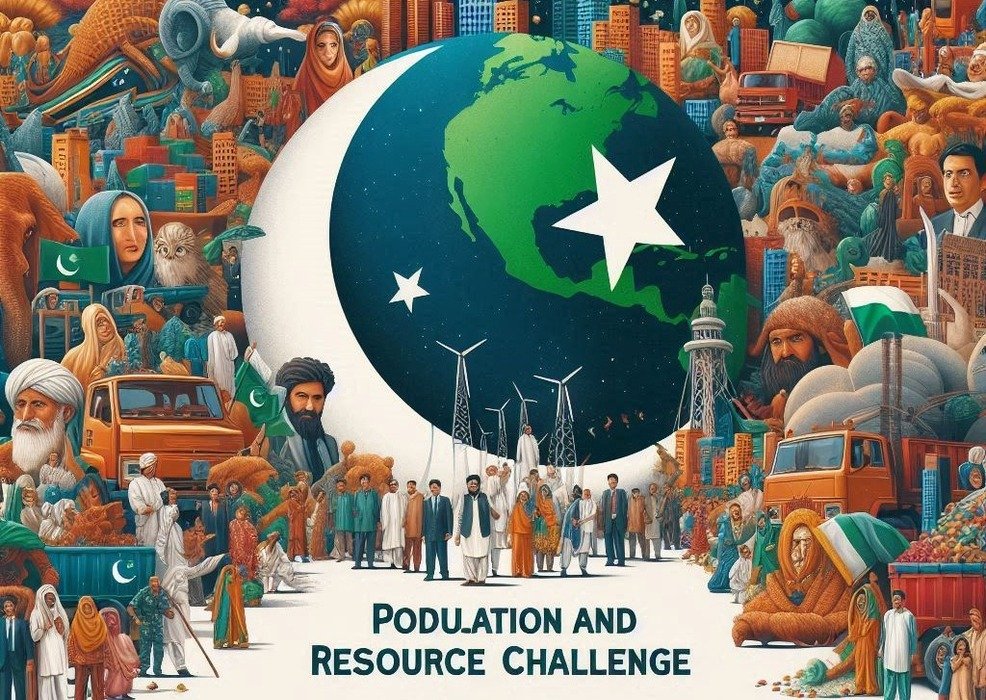Note from Pak NGOs: We are pleased to announce that this article is the 2nd best article in the competition. Congratulations to Mr. Wajahat Malik for writing such a wonderful piece. Please note that the Pak NGOs team has edited it to correct minor errors and improve clarity.
World Population Day, celebrated globally today, aims to share knowledge, and findings, and raise awareness about population issues, their adverse impacts on nations, societies, and the environment, and propose solutions. In the context of Pakistan’s population problem, the country faces a critical issue of overpopulation and high fertility rates, which demand urgent government attention.
Pakistan’s population stands at 241.49 million, with a fertility rate of 2.55%, according to the 7th Population and Housing Census 2023 by the Pakistan Bureau of Statistics. This rate is significantly higher than the economic growth rate. If unchecked, Pakistan’s population could reach 290 million by 2030. The 2017 census estimated the population at 207 million, reflecting an increase of approximately 35 million in just six years. This rapid growth is alarming for an economically unstable nation with high inflation and unemployment rates.
According to Worldometer’s elaboration of the latest United Nations data, Pakistan’s current population is 245.215 million, with a fertility rate of 3.28%. Pakistan is the fifth most populous country globally and the second largest Muslim population country, making up 2.99% of the world’s total population. These figures are concerning for a developing nation with inadequate resources, infrastructure, and socio-economic status. Unchecked population growth will overburden the country’s infrastructure and resources, further deteriorating its already weak economy.
Several factors contribute to overpopulation in Pakistan, including high birth rates, insufficient reproductive health and family planning services, disuse of modern contraceptive methods, high child and maternal mortality rates, poverty, illiteracy, unemployment, early marriages, and socio-cultural and religious practices that encourage having many children. A recent study estimated that women in Pakistan experience 3.8 million unintended pregnancies annually due to the lack of modern contraceptive use.
The consequences of overpopulation include increased demand for food, water, housing, energy, education, healthcare, and transportation, leading to environmental pollution, climate change, malnutrition, unemployment, poverty, substandard education and healthcare facilities, increased crime rates, and a sluggish economy.
Nations worldwide have adopted best practices to address overpopulation for their development. A notable example is Bangladesh, a fellow Muslim country, which adopted effective strategies for population management. In 1971, Bangladesh’s population was around 70 million, compared to Pakistan’s 60 million. Today, Bangladesh’s population is 174 million, while Pakistan’s exceeds 245 million. Bangladeshi policymakers focused on overpopulation, education, and preventive measures by introducing the National Family Planning Programme in 1976. This programme provided accessible and affordable family planning services, educating people about family planning through media and in-person campaigns, and ensuring the availability of contraceptives nationwide. As a result, Bangladesh’s fertility rate decreased from 7.5% in the 1970s to 1.9% in 2024. Given the similarities between Pakistan and Bangladesh, Pakistan can adopt similar practices to reduce its fertility rate to an optimal level.
To address Pakistan’s abnormal population growth, the following strategies and reforms need to be adopted by the government:
- Formulate a Five-Year National Action Plan: The government should develop a national action plan involving all relevant stakeholders. This plan should include result-oriented family planning services, reproductive health education programs, the use of contraceptives, free and compulsory quality education, promotion of gender equality, poverty elimination, employment opportunities, and ensuring fundamental rights. An oversight body should monitor the plan to check fertility and contraceptive prevalence rates annually, aiming to achieve a fertility rate below 2% and a 100% contraceptive prevalence rate within five years.
- Empower Girls and Women: Special attention should be paid to the education and healthcare of girls and women to increase their workforce participation. Educated and empowered women are more likely to make informed decisions about marriage, family planning, and contraception.
- Legislate and Enforce Minimum Marriage Age: The government should enforce a minimum marriage age of 18 years and mandate pre-marital family planning counseling. Couples should be incentivized to have only two children and delay the first pregnancy until the age of 20.
- Integrate Family Planning Services: Family planning services should be integrated with general and specialized healthcare facilities across the country.
- Collaborate with NGOs and Community-Based Organizations: The government, in collaboration with NGOs and community-based organizations, must ensure 100% coverage of families and homes for family planning counseling and contraceptive services. Contraceptives should be easily available to the public free of cost at community access points.
- Sensitize Key Stakeholders: Political leaders, the corporate sector, academia, judiciary, media, intelligentsia, civil society, religious leaders, and youth must be sensitized about the overpopulation problem to participate in family planning campaigns.
- Engage Religious Leaders: Religious leaders play a significant role in shaping public opinion. They should be engaged to advocate and endorse the national narrative on family planning, disseminating family planning messages in their sermons at worship places.





Add a comment